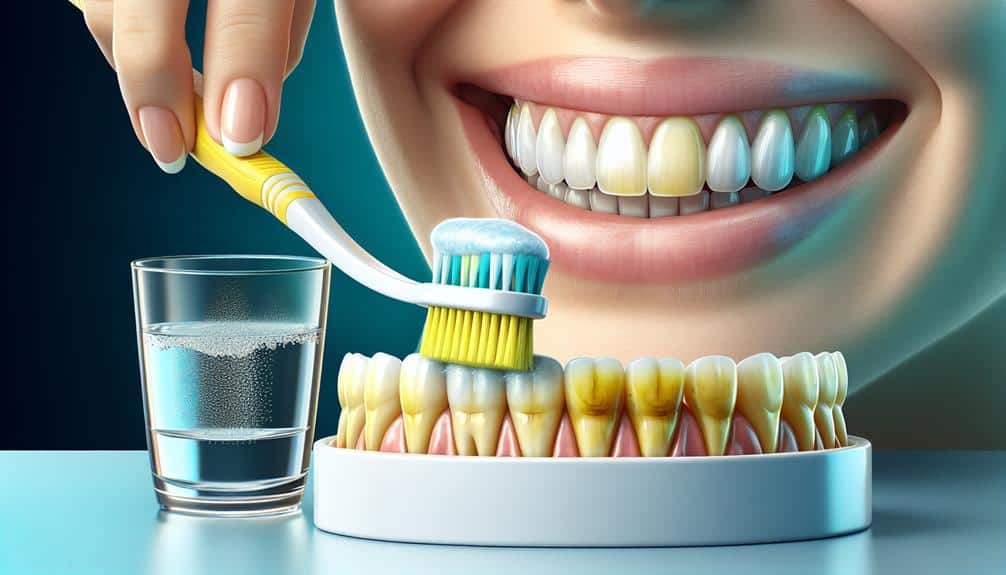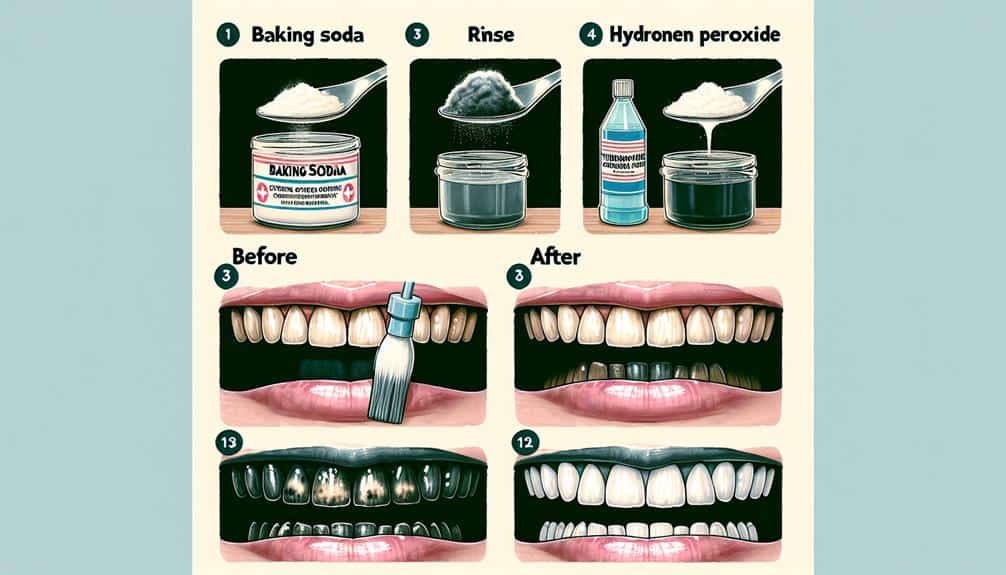To whiten tetracycline-stained teeth effectively, seek professional treatments like laser whitening tailored to your needs. High-concentration bleaching gels provide noticeable results. Home remedies such as baking soda and hydrogen peroxide can help. Remember to follow instructions to prevent harm. Discuss potential risks such as sensitivity with your dentist. Maintain whitened teeth with consistent oral care. Preserve brightness with whitening toothpaste and regular check-ups. Consult for personalized advice on maintaining results. Discover the complete guide to whiten tetracycline-stained teeth for lasting effects.
Key Points
- Professional whitening treatments like laser therapy provide accelerated results.
- Home remedies such as baking soda and hydrogen peroxide can help whiten teeth.
- Over-the-counter options like whitening toothpaste and strips offer convenient solutions.
- Consistent oral hygiene practices are crucial for maintaining whitened teeth.
- Consulting with a dentist before starting any whitening regimen is highly recommended.
Understanding Tetracycline Stains
Understanding tetracycline stains is essential for determining the most effective whitening methods for tetracycline-stained teeth. These stains occur as a result of the antibiotic tetracycline binding to calcium ions in developing teeth, leading to discoloration that ranges from yellow to dark brown or gray. The causes of tetracycline stains are primarily related to the use of tetracycline antibiotics during childhood when teeth are still developing.
Prevention of tetracycline stains involves avoiding the use of tetracycline antibiotics during pregnancy and in children under the age of 8, as this is the critical period for tooth development. Dentists should be cautious when prescribing tetracycline to pregnant women or children and consider alternative antibiotics when necessary to prevent these stains from forming. Additionally, proper oral hygiene practices, such as regular brushing, flossing, and dental check-ups, can help maintain the overall health and appearance of teeth, reducing the risk of developing tetracycline stains.
Professional Whitening Treatments
Professional whitening treatments offer effective solutions for addressing tetracycline-stained teeth, restoring a brighter and more uniform smile. Dentists utilize advanced technologies to provide customized treatments tailored to your specific needs. These advanced technologies include laser whitening, which accelerates the whitening process by activating the whitening gel with a specialized light. Additionally, professional whitening treatments often use high-concentration bleaching gels that are more powerful than over-the-counter options, ensuring more noticeable results.
During a professional whitening treatment, your dentist will carefully assess your teeth and oral health to determine the best course of action. They'll then apply the whitening agent to your teeth, ensuring that your gums and other sensitive areas are protected throughout the procedure. The customized nature of professional whitening treatments allows for a more controlled and precise whitening process, minimizing the risk of sensitivity or damage to your teeth.
Home Remedies and Over-the-Counter Options
To explore alternative options for whitening tetracycline-stained teeth, consider looking into home remedies and over-the-counter solutions that may offer effective results in enhancing the brightness of your smile.
Natural alternatives like baking soda, hydrogen peroxide, and activated charcoal have been suggested as DIY solutions to help whiten teeth. Baking soda, known for its mild abrasive properties, can gently remove surface stains when mixed with water to form a paste. Hydrogen peroxide, a common ingredient in many whitening products, can act as a bleaching agent to lighten teeth. Activated charcoal, although messy, is believed to absorb toxins and stains from the teeth, contributing to a whiter appearance.
Over-the-counter options such as whitening toothpaste, whitening strips, and whitening kits are easily accessible and can provide noticeable results over time. When choosing these methods, it's essential to follow the instructions carefully to avoid potential harm to the enamel or gums.
Experimenting with these natural alternatives and DIY solutions can be a cost-effective way to address tetracycline stains and improve the overall whiteness of your teeth.
Potential Risks and Side Effects
Potential risks and side effects associated with whitening methods for tetracycline-stained teeth should be carefully considered before choosing a treatment option. When it comes to long-term effects, some whitening procedures may lead to increased tooth sensitivity, especially if the enamel is already compromised by tetracycline staining. Prolonged use of certain whitening agents could potentially harm the enamel, causing it to weaken over time. Additionally, excessive use of whitening products may irritate the gums, leading to discomfort and even gum recession if not used properly.
Allergic reactions are another important risk to be aware of when undergoing whitening treatments for tetracycline-stained teeth. Some individuals may be sensitive to the ingredients in whitening products, resulting in oral irritation, swelling, or even difficulty breathing in severe cases. It's vital to perform a patch test or consult with a dentist before starting any whitening regimen to prevent adverse allergic reactions.
Considering these potential risks and side effects, it's essential to weigh the benefits against the possible drawbacks when selecting a whitening method for tetracycline-stained teeth. Prioritize your oral health and consult with a dental professional to determine the most suitable treatment option for your specific needs.
Maintaining Whitened Results
To maintain the results of your whitened tetracycline-stained teeth, diligent oral hygiene practices and regular dental check-ups are essential. Long-term maintenance of whitening results requires a commitment to preventive measures that hinder discoloration. Consistent oral hygiene routines, including brushing at least twice a day and flossing daily, play an important role in preserving the brightness of your teeth. Using a whitening toothpaste can also aid in preventing surface stains from developing.
Regular visits to your dentist are equally important. Professional cleanings help remove any plaque or tartar buildup that could diminish the effects of whitening treatments. Your dentist can also provide guidance on specific oral care products tailored to maintain your whitened teeth. Additionally, they can identify any early signs of staining or discoloration, allowing for prompt intervention to sustain the whiteness of your teeth.
Frequently Asked Questions
Can Tetracycline-Stained Teeth Be Effectively Whitened With Natural Remedies or DIY Treatments?
You can explore natural remedies and DIY treatments for whitening tetracycline-stained teeth. However, professional whitening procedures are more effective. Consider lifestyle changes for long-term results. Consult with a dentist for personalized advice on the best approach.
Are There Any Specific Dietary or Lifestyle Changes That Can Help Prevent Tetracycline Stains From Worsening?
To prevent tetracycline stains from worsening, consider dietary supplements and oral hygiene. Lifestyle changes like avoiding tobacco and maintaining good dental habits are preventive measures. Consistent care can help protect teeth from further discoloration.
How Long Does It Typically Take to See Noticeable Results From Professional Whitening Treatments for Tetracycline-Stained Teeth?
To see noticeable results from professional whitening treatments for tetracycline-stained teeth, it typically takes a few sessions over weeks. Long term maintenance involves follow-up appointments. Potential side effects and treatment duration vary based on individual factors.
Are There Any Specific Toothpaste or Mouthwash Products That Are Recommended for Maintaining the Results of Whitening Treatments for Tetracycline Stains?
To maintain whitening treatment results for tetracycline-stained teeth, consider using whitening toothpaste and mouthwash. These products can help preserve the effects of cosmetic dentistry procedures like veneers and prolong the brightness of your smile.
Are There Any Alternative Treatments or Procedures That Can Be Used in Combination With Whitening Treatments to Improve the Overall Appearance of Tetracycline-Stained Teeth?
To enhance the appearance of tetracycline-stained teeth, consider combining whitening treatments with laser therapy, veneers, cosmetic bonding, or enamel microabrasion. These procedures can complement whitening for a more all-encompassing transformation.



